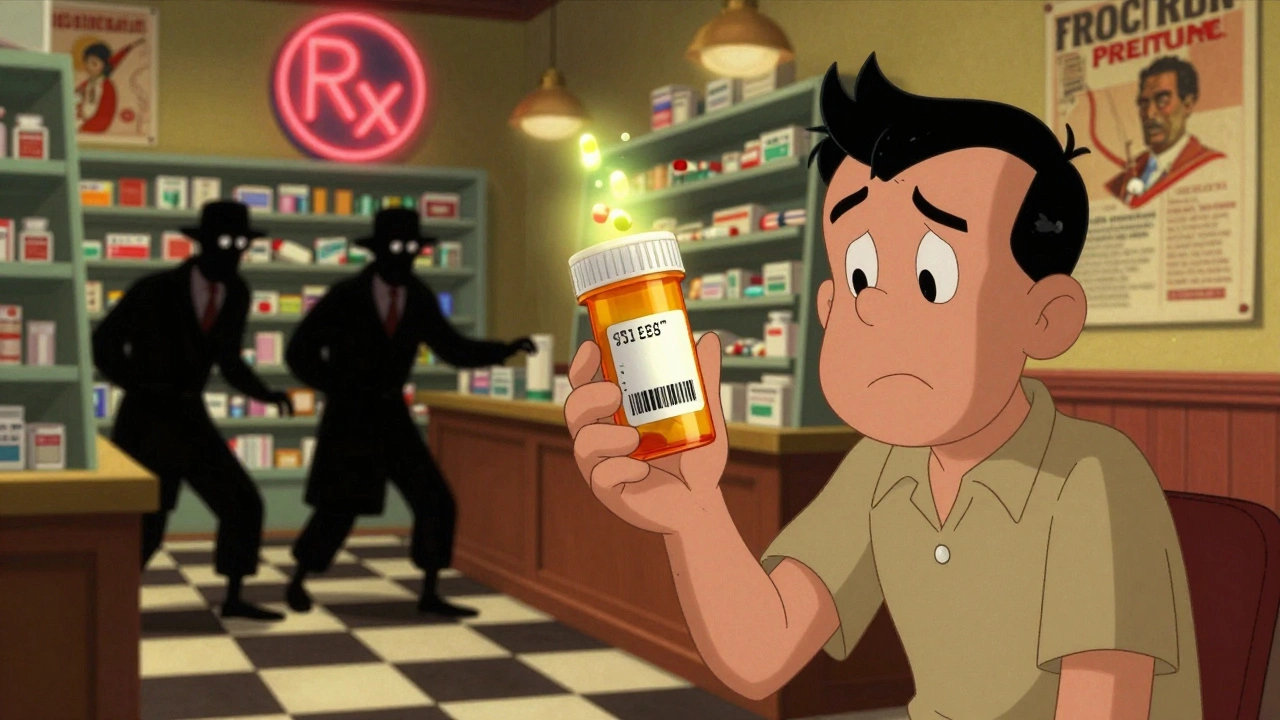It always seems to hit when life is at its busiest. One minute, you’re making weekend plans or finally ticking things off your to-do list, and the next, you’re knocked flat by fever, chills, and that unmistakable pounding in your head. The flu doesn’t care if you’re ready or not—and that’s where Tamiflu comes charging into the conversation, grabbing everyone’s attention whenever flu season heats up. But does it live up to the hype, or is it just another pill we’re told to take and hope for the best?
What is Tamiflu and How Does It Really Work?
First, a bit of background—Tamiflu is the brand name for oseltamivir, an antiviral medication that hit the U.S. market back in 1999. It grabbed headlines because, unlike plain old pain relievers, Tamiflu goes after the flu virus itself. It doesn’t stop you from getting the flu like a vaccine does. Instead, it steps in once the virus is inside you, getting to work to stop it from multiplying. Basically, Tamiflu works by blocking an enzyme called neuraminidase that lets the virus slip out of infected cells and invade new ones. Cut the supply line, and the viral army can’t spread as easily. That means your symptoms could fade faster, and you might not feel quite as rotten as you would without it.
You’ve probably heard that Tamiflu only works if you take it early, and that’s spot on. Studies show it’s most effective if you start swallowing those capsules within 48 hours of your first symptoms. The reason is pretty simple: by the time you’re already deep into the miserable stage, the flu virus has had plenty of time to multiply and take over. Hit it early, and there’s still a shot at reining things in. That’s part of why so many parents are on high alert when their kids start sniffling or spiking a fever. In fact, during the 2017-2018 flu season—the worst in a decade—doctors wrote over 4 million Tamiflu prescriptions in the U.S. alone, with parents and caregivers leading the charge. Tamiflu can be used for both adults and kids as young as two weeks old, though dosing varies by weight and age.
So, what sort of results should you actually expect? Here’s the bottom line: Tamiflu isn’t magic, it won’t cure the flu in a few hours, and it isn’t a substitute for the flu shot. In solid tracking studies, people with confirmed flu who took Tamiflu shaved about a day off their symptoms compared to those who just toughed it out. Sounds a bit underwhelming, but if you’re flat on your back with body aches, 24 hours less misery can feel pretty sweet. What’s more, Tamiflu can lower your risk of flu-related complications, which is a big deal if you’re in a high-risk group like young kids, folks over 65, pregnant people, or those with asthma or diabetes.
If you’re curious how Tamiflu stacks up against other ways of fighting the flu, here are some basics in a handy table you won’t find buried in a pamphlet at your local pharmacy:
| Method | Average Symptom Reduction | Reduces Flu Complications | Best For |
|---|---|---|---|
| Tamiflu (oseltamivir) | About 1-1.5 days faster | Yes | High-risk groups, recent exposure |
| Rest & Fluids | None | No | Most healthy adults |
| Acetaminophen/Ibuprofen | No reduction, only symptom relief | No | All ages |
| Flu Vaccine | Prevents infection, doesn’t treat | Yes (by preventing flu) | Everyone over 6 months |
Should you use Tamiflu every time you get a cold or fever? Not quite. Tamiflu only works for influenza viruses (types A and B), and it won’t touch other viral or bacterial bugs. If you start it late, it’s less likely to help, so always check with your doctor if you aren’t sure what’s actually making you sick.
Who Should Take Tamiflu—and Who Shouldn’t?
Doctors don’t hand out Tamiflu to everyone with the sniffles. If you’re relatively healthy and under 65, your chances of a bad outcome from the flu are low—unpleasant, yes, but not usually dangerous. But if you, or someone around you, fits into certain categories, Tamiflu can actually make a meaningful difference.
- Babies under 5 years old (and especially younger than 2)
- People 65 or older
- Pregnant individuals or those up to 2 weeks postpartum
- Anyone with chronic lung, heart, kidney, liver, or immune system problems
- Those living in nursing homes or group homes
- Anyone with severe obesity (BMI over 40)
For these groups, flu can spiral quickly into pneumonia, hospitalization, or even death. Studies in nursing homes show that putting residents on Tamiflu after exposure cuts infection rates by over 89%. That’s a big deal in places where flu can spread like wildfire. If you land in a category like this, many doctors prescribe Tamiflu at the first sign of flu, or even preventively if you’ve had close contact with someone confirmed to have it.
Let’s flip that around—if you’re a healthy adult or teenager, Tamiflu is mostly about comfort. You might feel better a day faster, but you’d probably come through the illness just fine without it. Some folks are even more cautious about using Tamiflu: if you have severe allergies to oseltamivir, have had hallucinations on it before (extremely rare, but documented), or have a history of kidney trouble, your doctor will weigh the risks and benefits carefully. People with simple colds, coughs, or stomach bugs don’t get the green light for Tamiflu at all. It targets the flu, not every sniffle.
And not everyone tolerates it perfectly. About 1 in 10 report some queasiness, and a smaller chunk—maybe 2 or 3 out of every 100—might get a headache or some mild stomach pain. Very rarely, children have had odd behavioral side effects like confusion or bizarre dreams. The FDA even issued a warning about this back in 2006, after cases mostly in Japan. Still, millions have safely taken Tamiflu since then. No medication is completely risk-free, of course, so if you’re worried or your symptoms get worse, it’s smart to call your provider for advice.
Here’s a tip: if one member of your family comes down with the flu, Tamiflu can sometimes be prescribed to others in the household to help prevent it—especially if you’re living with someone at high risk of complications. In these cases, the preventive dosage is usually half the treatment dosage, and you might need to keep taking it for up to 10 days.

How to Take Tamiflu for Best Results (and What to Avoid)
This is where so many people trip up. Waiting until day three or four, hoping you’ll start to feel better, then reaching for Tamiflu—it just doesn’t do much at that point. For Tamiflu to really work its magic, you want to take the first dose within 48 hours of those classic flu symptoms—fever, chills, sore throat, body aches, and a fatigue that makes you want to sleep for days. That “within 48 hours” advice isn’t just a nice guideline, either—a 2023 study from the CDC showed starting Tamiflu on the first day of symptoms reduced hospitalizations by 27% in high-risk adults, compared to those who didn’t take it until day three or four.
Tamiflu usually comes as a capsule or a liquid. Dosage for adults? 75 mg twice a day for 5 days. For kids, the dose goes by weight, and younger kids get a syrup. If you miss a dose, just skip it and get back to your regular schedule—you don’t need to double up. Always take it with food if you’re prone to nausea. And if you have trouble swallowing capsules, pharmacies can sometimes convert Tamiflu into a suspension that’s easier to take.
If your doctor prescribes Tamiflu as a preventive (what they call prophylaxis), the most common schedule is 75 mg once a day for at least 10 days after exposure. Remember, taking Tamiflu every time a coworker sneezes isn’t the answer, but if there’s a major flu outbreak at your kid’s school or you live with someone vulnerable, your doctor may say yes.
One thing that shocks first-timers: don’t expect Tamiflu to instantly wipe out a fever. You’ll still need fluids, rest, and maybe over-the-counter Tylenol or ibuprofen for a few days. Drinking a little extra water helps, since dehydration can make flu symptoms even worse. Some folks swear by starting Tamiflu and a soup marathon at the same time—it doesn’t hurt!
And while the Internet is full of home remedies, don’t combine Tamiflu with herbal flu cures or other medications—especially those with acetaminophen or ibuprofen—without checking with a pharmacist. Mixing drugs can pile up risks. If you’re on blood thinners or have kidney problems, there could be interactions to watch for.
Don’t save leftover Tamiflu for the next time someone gets sick. The virus changes every year, your dose may need adjusting, and expired meds just don’t work as well. If you have old capsules, return them to a pharmacy take-back program.
What Science Really Says About Tamiflu—Hype, Myths, and Facts
Every flu season, there’s an epic debate: Is Tamiflu worth it or just a placebo in a fancy box? You’ll hear skeptics pointing to trials where symptoms only improved a little faster than placebo. Drug companies face backlash for holding back company studies and overhyping the wonders of Tamiflu in years past. On the flip side, public health experts point out that when disaster strikes—think the 2009 H1N1 “swine flu” pandemic—Tamiflu helped prevent thousands of hospitalizations and kept emergency rooms from overflowing.
So what’s the real story? First, yes, Tamiflu shortens flu symptoms by about a day—sometimes up to 36 hours—if taken right away. For most healthy adults, that might not seem like much unless you’re desperate to get back to work. Where it shines brightest is in groups who face life-threatening complications from the flu. In folks over 65, Tamiflu doesn’t just shorten illness—it can drop the risk of pneumonia by up to 44%, and the odds of winding up hospitalized by nearly 40%, according to a 2022 meta-analysis of over 30,000 patients.
Public health authorities, like the CDC and WHO, keep Tamiflu in stockpiles for emergencies because in an outbreak, the biggest risk isn’t feeling lousy—it’s the spiral into pneumonia, hospitalization, and death, especially in people with chronic illnesses or weak immune systems. And when one person gets the flu in a tight-knit setting like a family, college dorm, or nursing home, giving Tamiflu to close contacts (called post-exposure prophylaxis) can drop their odds of getting sick by about 75%. Clever strategy, especially in years with a rough flu strain or poor vaccine match.
But not every year is the same. Flu strains mutate constantly, and sometimes the virus shifts in ways that make it a little less sensitive to Tamiflu. Thankfully, full resistance is rare—only about 1% of U.S. flu viruses have shown strong resistance to oseltamivir. Still, doctors pay attention and may shift approaches if resistance starts to climb.
One big Tamiflu myth is that it works against every bug that lands you in bed—nope! Tamiflu can’t touch COVID-19, RSV, or the common cold. During the COVID pandemic, pharmacies even sign-posted this fact, because people wanted something, anything, to ward off the mysterious virus. The two viruses are totally unrelated, so Tamiflu is strictly for true influenza.
And before you spend a fortune stockpiling Tamiflu for next year: the CDC and FDA don’t recommend hoarding, because the medication has a shelf life. If you get a prescription, use it for the intended illness that season. Most pharmacies now refuse to refill Tamiflu without a recent visit and confirmed reason, to prevent shortages for high-risk groups.
Finally, is Tamiflu “worth it”? If you’re healthy and have a strong immune system and just want to ride out the wave, you might pass and focus on rest and hydration. If you fall into one of those riskier categories, have loved ones who do, or just want to get back to daily life a little faster, it can definitely make a difference. I only needed Tamiflu once, but my wife, Amelia, who has asthma, keeps it on standby each winter—her doctor says that’s wise, given her history.
The best advice? Know your body, talk to your doctor early if flu hits, and don’t count on any medicine to replace the basics—flu shots, hand washing, and sick-day rest. Tamiflu’s a tool, not a magic cure, but for those who need it, it really does move the needle.






Ifeoluwa James Falola
May 30, 2025 AT 07:31Just took Tamiflu last week. Felt like a zombie for 3 days anyway. Didn’t save me from missing work. Still got the cough.
Julie Lamb
May 30, 2025 AT 22:39My grandma took it after her flu test came back positive and she’s 78 with COPD. She said she felt less awful by day 3 instead of day 5. I’m keeping a bottle in the cabinet now 🙏
Scott Horvath
May 31, 2025 AT 20:36My kid’s school had a flu outbreak last year. They gave Tamiflu to everyone who had close contact. Only 2 kids got sick after that. I’m not saying it’s magic but it’s not placebo either. My wife thinks it’s the flu shot that did it but I’m not taking chances anymore
jennifer sizemore
June 1, 2025 AT 05:00I used to think Tamiflu was just Big Pharma hype until my brother got hospitalized with flu pneumonia. He’s 42, healthy, no underlying conditions. They gave him Tamiflu on day 2 and he was out in 5 days instead of 10. I’ll never doubt it again
Wayne Rendall
June 1, 2025 AT 23:40It is worth noting that the Cochrane Collaboration's 2014 systematic review, updated in 2021, concluded that while oseltamivir reduces symptom duration by approximately 16.8 hours in adults, the evidence for reduction in hospitalizations or complications remains inconclusive. The drug's benefit is marginal for low-risk populations, and its cost-benefit ratio must be weighed against potential adverse effects such as nausea and psychiatric events in pediatric cases.
Rishabh Jaiswal
June 2, 2025 AT 16:07u think tamiflu works but what about the fact that the company hid data for years? they only released 10% of the trials and now everyone thinks its a wonder drug. i saw a doc on netflix about it. its all a scam. the real cure is vitamin c and garlic
Patrick Ezebube
June 3, 2025 AT 02:58They don’t want you to know the truth. Tamiflu was developed by a shadowy pharmaceutical consortium tied to the WHO and the CDC. The real reason they push it is to keep people dependent on pills instead of letting their immune systems evolve. Did you know the FDA banned it in 1998 but quietly re-approved it after a secret meeting with Roche? And the side effects? Hallucinations? That’s not a side effect-that’s the government testing mind control tech on the public. Wake up. The flu isn’t the virus-it’s the system.
Adam Phillips
June 3, 2025 AT 07:04so like the body has its own way of dealing with stuff right like why do we even need to interfere with enzymes and all that like nature knows better than chemists and pills and all that
Dale Yu
June 3, 2025 AT 14:55you people are so naive. you think a pill fixes anything. the flu is your body purging toxins from the vaccines. tamiflu just masks it so they can keep pushing more shots. you’re being used. i’ve had the flu 5 times and never took it. i’m still standing. you think that’s luck? no. it’s resistance
april kakoske
June 4, 2025 AT 09:11my mom swears by it. she’s 69 and has diabetes. she says it saved her life last year. i used to roll my eyes but now i get it. sometimes you need a little help when your body’s fighting a war
Matt Renner
June 4, 2025 AT 15:36As a clinical pharmacist with over 15 years of experience, I can confirm that the most robust evidence supporting oseltamivir’s efficacy is in high-risk populations, particularly in reducing lower respiratory tract complications and hospitalization duration. The 1-day symptom reduction in otherwise healthy individuals is statistically significant but clinically modest. Prophylactic use in close contacts of confirmed cases, however, demonstrates a 70–80% reduction in transmission risk, which is a critical public health benefit.
Vishnupriya Srivastava
June 4, 2025 AT 22:37Let’s be honest. Most people who take Tamiflu don’t even have the flu. They have a cold and panic. Doctors prescribe it because they’re scared of liability. The real problem is overdiagnosis and overmedication. Tamiflu is a Band-Aid on a bullet wound.
Armando Rodriguez
June 5, 2025 AT 08:28I appreciate the comprehensive breakdown. As a public health educator, I emphasize that Tamiflu is not a substitute for vaccination but a valuable adjunct during outbreaks. The key is early intervention and targeted use. We distribute it to nursing homes and schools only when flu activity is confirmed. This approach minimizes waste and maximizes impact. Thank you for highlighting the data.
Umesh Sukhwani
June 6, 2025 AT 08:09In India, access to Tamiflu remains limited outside urban centers. Many rely on Ayurvedic remedies like tulsi tea and ginger-honey mixtures. While I respect the scientific data, I also acknowledge cultural context. In rural households, rest, hydration, and herbal support remain primary. Tamiflu is a tool, not a universal solution. Respect both science and tradition.
Kshitij Nim
June 6, 2025 AT 09:06My cousin is a pediatrician in Delhi. She says if a kid under 5 has a fever and flu test is positive, she gives Tamiflu without hesitation. She says the risk of pneumonia in malnourished kids is real. I used to think it was overkill. Now I get it. It’s not about being extra. It’s about being smart.
Pradeep Meena
June 7, 2025 AT 03:44Why do you think America is so obsessed with pills? In India we know the truth. The flu is just your karma catching up. Tamiflu is a western scam to make you weak. Eat turmeric. Pray. Don’t take poison.
May Zone skelah
June 8, 2025 AT 01:34Oh darling, Tamiflu? How quaint. I mean, I suppose if you’re still clinging to the 20th-century notion of ‘viral replication’ and ‘neuraminidase inhibition’-how terribly reductive. Have you considered the quantum entanglement of influenza and collective human anxiety? The real cure is not in a capsule but in the alignment of your chakras during the winter solstice. I once took Tamiflu and still felt the existential dread of the flu-so clearly, the problem wasn’t the virus. It was the metaphysical dissonance. Also, my esthetician said my lymphatic system was clogged with corporate toxins. I drank celery juice for 14 days. I’m fine now.
Ramesh Deepan
June 8, 2025 AT 07:38Look, I’m not here to sell you anything. But if you’ve got a kid with asthma or an elderly parent, Tamiflu is worth the cost. I’ve seen families lose people because they waited too long. Don’t be the person who says ‘I thought it was just a cold.’ Act fast. Talk to your doctor. Don’t wait for the internet to tell you what to do.
matt tricarico
June 8, 2025 AT 09:31It’s interesting how the public clings to pharmacological solutions while ignoring the deeper issue: our modern lifestyle has destroyed immune resilience. We live in sanitized bubbles, eat processed food, sleep poorly, and then wonder why we get sick. Tamiflu is a Band-Aid on a broken civilization. The real question isn’t whether it works-it’s why we’ve allowed ourselves to become this fragile.